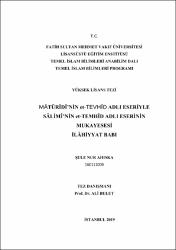Mâtürîdî’nin Et-Tevhîd Adlı Eseriyle Sâlimî’nin Et-Temhîd Adlı Eserinin Mukayesesi : İlâhiyyat Babı
Citation
AHISKA, Şule Nur, Mâtürîdî’nin Et-Tevhîd Adlı Eseriyle Sâlimî’nin Et-Temhîd Adlı Eserinin Mukayesesi : İlâhiyyat Babı, Fatih Sultan Mehmet Vakıf Üniversitesi Lisansüstü Eğitim Enstitüsü Temel İslam Bilimleri Anabilim Dalı, Yayımlanmamış Yüksek Lisans Tezi, İstanbul 2019.Abstract
Bu çalışmada, Mâtürîdî’nin “Kitabü’t-Tevhîd” adlı eseri ile Sâlimî’nin “Kitabü’t-Temhîd ” adlı eserinde yer alan “ilâhiyyat babı” mukayese edilmiştir. Burada özellikle bu iki âlimin eserlerini seçmemizin nedeni, öncelikle kelâmda Ehl-i sünnet temsilcilerinden olan ve Mâtürîdîyye mezhebinin kurucusu Mâtürîdî ile yine ondan sonra yaşayan, erken dönem âlimlerinden ve Hanefî-Mâtürîdî ekolünden olan Sâlimî’nin eseri arasında farklılığın olup olmadığını araştırmaktır.
Mâtürîdî, Hanefî mezhebine mensup olan ve bu mezhebi kelâm ilminde sistemleştirerek yeni bir ekol haline getiren kişidir. Bu nedenle amelde Hanefî mezhebine mensup olan kimselerin itikadda Mâtürîdîyye mezhebine mensubiyeti yaygındır.
Sâlimî ise Hanefî mezhebine mensuptur ve Mâtürîdî’den sonra yaşamıştır. Ancak eserinin birçok yerinde Ebû Hanîfe’ye atıf yapmasına rağmen Mâtürîdî’ye atıf yapmaması dikkat çekmektedir. Aslında açıkça atıf yapmasa da görüşlerinin çoğunun Mâtürîdî ile neredeyse aynı olduğu ve birkaç yerde “meşâyihi Semerkand” demesi ile de onu kasdettiği anlaşılmaktadır. Ayrıca birçok âlimin o dönemlerde Mâtürîdîyye mezhebine atıf yapmadığı, onun yerine Sâlimî’nin de yaptığı gibi “Ehl-i sünnet” demesi, üzerinde durulan konulardan olmuştur.Çalışmamızda ilâhiyyat babını seçerek Allah’ı tanımanın önemi üzerinde durduk. Bu bahsi seçerek kelâm ilmi vasıtasıyla yüce Allah’ı, hem aklî hem de naklî deliller ile tanıma ve iki değerli âlimin görüşlerini mukayese etme fırsatı yakalamış olduk. In this present study, the book of “Kitabu’t-Tevhîd” by Mâturîdî and topic of “ilâhiyyat babı” which is inside of “Kitabu’t-Temhîd” by Sâlimî have been compared. In particular, the reason why we chose the works of these two scholars is to investigate whether there is any difference between the work of Sâlimî, who is one of the representatives of the Ahl al-Sunnah and who is the founder of the Mâturîdiyye sect and who lived after him, and who are from the Hanefî / Mâtürîdî school of the early period.Mâturîdî is a person who belongs to Hanefî sect and makes this sect into a new school by systematizing it in the science of "kelâm”. For this very reason, the adherents of the Hanefî sects’ affiliation to Mâtürîdîyye membership in the creed is a common.Although Sâlimî is a member of Hanefî sect with many parts of his works referring to Abu Hanîfe, and despite the fact that he lived after Maturîdî, it was emphasized in this study that he did not refer to Matürîdiyye. Though it does not explicitly refer to it and most of the opinions are almost the same as those of Mâturîdî, it is noteworthy that it is called “meşayihi Semerkand” in several places which clearly shows that it is meant him. In addition, many scholars did not refer to the Mâdurîdiyye sect in those days; instead of it, as it is said that Sâlimî’s followers of Sunnah was the focus of the topic.
In our study, we emphasized the importance of recognizing Allah by choosing “ilâhiyyat babı”. We have had the opportunity to recognize this subject and to recognize Allah with both mental and transcendental evidences and compare the views of two esteemed scholars.



















